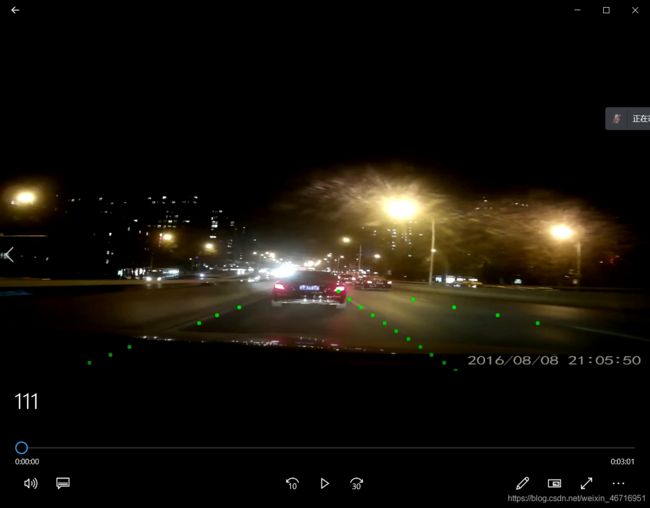Ultra-Fast-Lane-Detection方法测试自己的视频基于culane模型
Ultra-Fast-Lane-Detection方法测试自己的视频基于culane模型
1.修改demo.py
#-*-coding:GBK -*-
import torch, os, cv2
from model.model import parsingNet
from utils.common import merge_config
from utils.dist_utils import dist_print
import torch
import scipy.special, tqdm
import numpy as np
import torchvision.transforms as transforms
from data.dataset import LaneTestDataset
if __name__ == "__main__":
torch.backends.cudnn.benchmark = True
args, cfg = merge_config()
dist_print('start testing...')
assert cfg.backbone in ['18','34','50','101','152','50next','101next','50wide','101wide']
if cfg.dataset == 'CULane':
cls_num_per_lane = 18
elif cfg.dataset == 'Tusimple':
cls_num_per_lane = 56
else:
raise NotImplementedError
net = parsingNet(pretrained = False, backbone=cfg.backbone,cls_dim = (cfg.griding_num+1,cls_num_per_lane,4),
use_aux=False).cuda() # we dont need auxiliary segmentation in testing
state_dict = torch.load(cfg.test_model, map_location='cpu')['model']
compatible_state_dict = {}
for k, v in state_dict.items():
if 'module.' in k:
compatible_state_dict[k[7:]] = v
else:
compatible_state_dict[k] = v
net.load_state_dict(compatible_state_dict, strict=False)
net.eval()
img_transforms = transforms.Compose([
transforms.Resize((288, 800)),
transforms.ToTensor(),
transforms.Normalize((0.485, 0.456, 0.406), (0.229, 0.224, 0.225)),
])
cap = cv2.VideoCapture("/home/yxhuang/Ultra-Fast-Lane-Detection-master/data/test_video.mp4")
fourcc = cv2.VideoWriter_fourcc(*'MJPG')
vout = cv2.VideoWriter(str(111)+'.avi', fourcc , 30.0, (int(cap.get(3)),int(cap.get(4))))
print("w = {},h = {}".format(cap.get(3),cap.get(4)))
from PIL import Image
print("cuda:{}",torch.cuda.is_available())
while 1:
rval,frame = cap.read()
if rval == False:
break
# cv2.imwrite("ssss.jpg",frame)
# img_ = Image.open("ssss.jpg")
#frame = cv2.resize(frame, (288, 800))
img = cv2.cvtColor(frame,cv2.COLOR_BGR2RGB)
img_ = Image.fromarray(img)#实现array到image的转换
imgs = img_transforms(img_)
imgs = imgs.unsqueeze(0)#起到升维的作用
imgs = imgs.cuda()
with torch.no_grad():
out = net(imgs)
col_sample = np.linspace(0, 800 - 1, cfg.griding_num)
col_sample_w = col_sample[1] - col_sample[0]
out_j = out[0].data.cpu().numpy()
out_j = out_j[:, ::-1, :]
prob = scipy.special.softmax(out_j[:-1, :, :], axis=0)
idx = np.arange(cfg.griding_num) + 1
idx = idx.reshape(-1, 1, 1)
loc = np.sum(prob * idx, axis=0)
out_j = np.argmax(out_j, axis=0)
loc[out_j == cfg.griding_num] = 0
out_j = loc
# import pdb; pdb.set_trace()
# vis = cv2.imread(os.path.join(cfg.data_root,names[0]))
for i in range(out_j.shape[1]):
if np.sum(out_j[:, i] != 0) > 2:
for k in range(out_j.shape[0]):
if out_j[k, i] > 0:
ppp = (int(out_j[k, i] * col_sample_w * cap.get(3) / 800) - 1, int(cap.get(4) - k * 20) - 1)
cv2.circle(frame,ppp,5,(0,255,0),-1)
vout.write(frame)
vout.release()
注意自己视频的路径。
2.culane.py路径的修改
3.测试
python demo.py configs/culane.py --test_model model/cualne_18.pth


